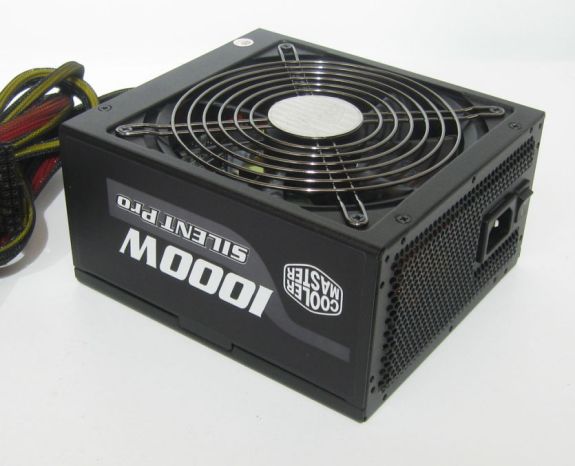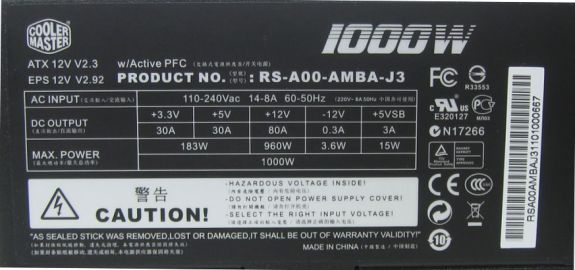Cooler Master Silent Pro M1000 1000W
by Martin Kaffei on September 5, 2010 10:30 PM EST- Posted in
- Cases/Cooling/PSUs
- PSUs
- 80Plus
- Cooler Master
- Silent Pro
Features and Delivery Contents
The delivery content is very generous and includes the modular connectors in a separate bag. In addition to the power cord and a set of screws, two anti-vibration frames are also included, along with the standard installation manual. A small card points out that the product has to be registered online to get the full 5-year of warranty.
The ATX 2.3-PSU is "SLI Ready" as usual in this power class. As a special feature, Cooler Master wants to focus on the heat sinks. These are aluminium sheets complemented with copper plates (which increase the total volume of the heat sink) on the semiconductors. The copper should help dissipate the heat much better. The PSU dimensions are 150 (w) x 86 (h) x 165 (l) mm and Cooler Master promotes the single +12V rail and a Japanese electrolytic capacitor for filtering. The product homepage emphasizes the protection-IC and the flat cables as interesting features; the cables are the same as in preceding models.
Cooler Master puts a lot of its efforts into the case of the PSU. Even though the grey surface and the stylistically confident aesthetics are not really part of our review criteria, the robust powder coating and the thickness of the material are nice features. The casing in particular should help shield other devices from electromagnetic interference. The rear side with the small honeycombed ventilation holes is also very sturdy and doesn't show the flex typical in other power supplies on this area. A small power switch is right next to the AC-inlet. The Cooler Master logo is visible on one side as well as on the fan grill.
Like previously mentioned the Silent Pro uses a single +12V rail, rated at 80 amps and measured generously. The smaller +3.3V and +5V rails are specified at 30A each and should deliver 183 watts, which will be considered in our load tests.













22 Comments
View All Comments
pg55555 - Sunday, September 5, 2010 - link
Your main complain is noise, but your table indicates 20dB up to 50% load, 22dB at 80% and you complain because it becomes louder (35dB) when you overload??Form a table I got from other site:
TYPICAL SOUND LEVELS
Jet takeoff (200 feet) 120 dBA
Construction Site 110 dBA Intolerable
Shout (5 feet) 100 dBA
Heavy truck (50 feet) 90 dBA Very noisy
Urban street 80 dBA
Automobile interior 70 dBA Noisy
Normal conversation (3 feet) 60 dBA
Office, classroom 50 dBA Moderate
Living room 40 dBA
Bedroom at night 30 dBA Quiet
Broadcast studio 20 dBA
Rustling leaves 10 dBA Barely audible
So you are saying it is louder than expected because its sound level - up to more than 50% load (this is 500W what would require an i7 920 OC at 4.0 GZ with an HD5970) - is similar to a Broadcast studio?
cactusdog - Monday, September 6, 2010 - link
Its loud compared to the manufacturer's claim of silence. There are plenty of PSU's that are silent. They should have called it the "CoolerMaster Nearly Silent Pro"cactusdog - Monday, September 6, 2010 - link
My experience with fans is 20dB is just audible in a quiet room. 22dB(80% load) is clearly audible so it cant claim to be silent.7Enigma - Monday, September 6, 2010 - link
You also have to remember that different frequencies of sound are perceived differently to the human ear. There can be some very annoying quiet sounds (high frequency can be horrible), while some loud sounds (especially low frequency) can't even be perceived. Take your home theater sub; below about 15-20Hz can no longer be heard, but can be physically felt.When calibrating my SVS PV-10 with a single tone drop from 150-0Hz it got to a point where I heard nothing but the walls were shaking. Really creepy and cool at the same time. I'm kind of shocked more horror movies don't put some odd inaudible noises in just to make your house moan. :)
sonicology - Monday, September 6, 2010 - link
Another 1000W PSU is great for those running overclocked hex-core quad SLI set-ups, however what I would really like and what nobody seems to offer is an 80 Plus Gold or Platinum 300W PSU that runs near enough silent.I guess consumers only care about huge wattage ratings that they don't even come close to using whilst the quality low watt PSUs go to the large OEMs?
7Enigma - Monday, September 6, 2010 - link
You're just not going to find a 300w quality supply. 400-500 yes and that is where I normally shop, but everything does tend now to be above that range.And as for your second statement, quality OEM PSU's? Thanks for the laugh.....:)
Sabresiberian - Wednesday, September 8, 2010 - link
Actually, this PSU wouldn't work for hex-core quad SLI. Oh, there might be 4 SLI capable video cards that it could power, but I highly doubt it.There really is use for the high end PSUs. Consider the person who installs 2 Geforce 480s in SLI. That person needs 42A for each card for a total of 84A, which automatically makes this PSU unsuitable, because it is rated to supply a maximum of 80A @ 12V, and that's not including anything else that runs on 12V. A person considering 2 480s in SLI needs to consider a 1200W PSU, and needs to pay close attention to the rails on the one he/she buys, so that each the cards don't try to draw more power from a rail than it is rated to supply.
The fact is, Anandtech rates lower power PSUs on as regular a basis as much as they do the higher end units. True, I haven't seen them rate any 300W PSUs in quite awhile, but it takes very little these days to need more than that, considering modern CPUs and video cards (the CPU alone would take up 1/3 to 1/2 the power). Anandtech was started as and I think still is primarily a site for enthusiasts, and there aren't many people who are going to build with a 300W PSU.
Maybe there's some apps for them though; HTPC? Still, it seems to me that a suggestion could be made in a positive tone rather than one that bashes people for being interested in the high end market.
Consider too, that review sites often tell us about the products that manufacturers send them for evaluation, and manufacturers send flagship models. What the manufacturer tends to think is if you read a good review about their top end PSU, you'll buy a lower end unit thinking it's built with the same care. Unfortunately, that's often not the case, especially with PSUs, so your point is quite valid, they should be tested on their own.
r3quiem - Tuesday, December 20, 2011 - link
You clearly have no Idea what you are taking about in regards to the GTX 480's in SLI. The maximum powerdraw of a single GTX 480 is 250 watts / 12V rail = 21A not 42A. Now Two GTX 480's in SLI would use a Total Max of 42A there by saturating slightly more than 50% of the 12V Rail.Now if you look the CPU side even the power hungry Hexa Core i7-990X is rated at 130 Watt TDP. Doing some simple match 130W / 12V = 10.8 A.
So in total without overclocking we only just used up 63 A out of the available 80A leaving 17A more headroom to play around with overclocking as you need it. And that's only if everything is working at 100% load which isn't a likely scenario unless you are running multiple benchmarks at a time.
7Enigma - Monday, September 6, 2010 - link
Article seems a bit odd without any introduction, just jumping right into the contents of the product. Me thinks a page is missing!Martin Kaffei - Monday, September 6, 2010 - link
Sry, you're right. Fixed!I agree with cactusdog. Of course we have seen worse results. But in this case, the manufacturer is using the word "Silent" in his name. So it shouldn't be louder than the smaller Silent Pro, which are very quiet.
http://www.anandtech.com/show/2613/8